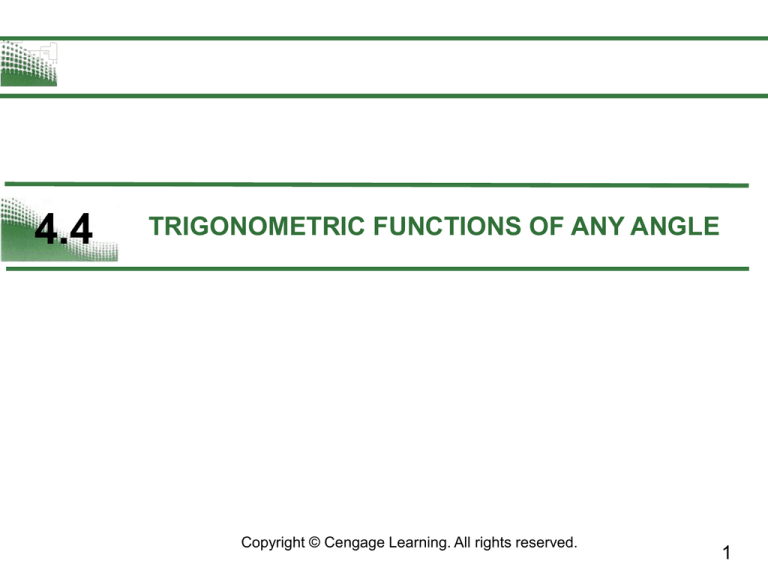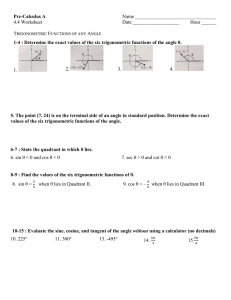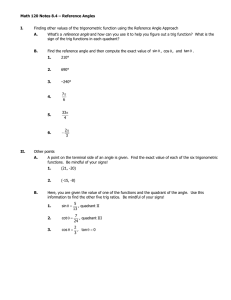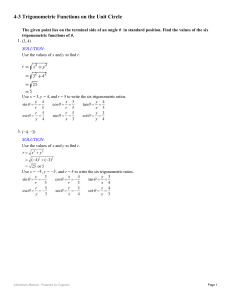4.4 trigonometric functions of any angle
advertisement

4.4 TRIGONOMETRIC FUNCTIONS OF ANY ANGLE Copyright © Cengage Learning. All rights reserved. 1 What You Should Learn • Evaluate trigonometric functions of any angle. • Find reference angles. • Evaluate trigonometric functions of real numbers. 2 Introduction 3 Introduction 4 Example 1 – Evaluating Trigonometric Functions Let (–3, 4) be a point on the terminal side of . Find the sine, cosine, and tangent of . Solution: x = –3, y = 4, 5 Example 1 – Solution cont’d 6 Introduction 7 Reference Angles 8 Reference Angles 9 Reference Angles The reference angles for in Quadrants II, III, and IV. ′ = – (radians) ′ = 180 – (degrees) ′ = – (radians) ′ = – 180 (degrees) ′ = 2 – (radians) ′ = 360 – (degrees) 10 Example 4 – Finding Reference Angles Find the reference angle ′. a. = 300 b. = 2.3 c. = –135 11 Example 4(a) – Solution Because 300 lies in Quadrant IV, the angle it makes with the x-axis is ′ = 360 – 300 = 60. Degrees 12 Example 4(b) – Solution cont’d Because 2.3 lies between /2 1.5708 and 3.1416, it follows that it is in Quadrant II and its reference angle is ′ = – 2.3 0.8416. Radians 13 Example 4(c) – Solution cont’d First, determine that –135 is coterminal with 225, which lies in Quadrant III. So, the reference angle is ′ = 225 – 180 = 45. Degrees 14 Trigonometric Functions of Real Numbers 15 Trigonometric Functions of Real Numbers By definition, you know that sin = tan = and . For the right triangle with acute angle ′ and sides of lengths | x | and | y |, you have sin ′ = = tan ′ = = and . opp = | y |, adj = | x | 16 Trigonometric Functions of Real Numbers 17 Example 5 – Using Reference Angles Evaluate each trigonometric function. a. cos b. tan(–210) c. csc 18 Example 5(a) – Solution cont’d Because = 4 / 3 lies in Quadrant III, the reference angle is as shown in Figure 4.44. Moreover, the cosine is negative in Quadrant III, so Figure 4.44 19 Example 5(b) – Solution cont’d Because –210 + 360 = 150, it follows that –210 is coterminal with the second-quadrant angle 150. So, the reference angle is ′ = 180 – 150 = 30, as shown in Figure 4.45. Figure 4.45 20 Example 5(b) – Solution cont’d Finally, because the tangent is negative in Quadrant II, you have tan(–210) = (–) tan 30 = . 21 Example 5(c) – Solution cont’d Because (11 / 4) – 2 = 3 / 4, it follows that 11 / 4 is coterminal with the second-quadrant angle 3 / 4. So, the reference angle is ′ = – (3 / 4) = / 4, as shown in Figure 4.46. Figure 4.46 22 Example 5(c) – Solution cont’d Because the cosecant is positive in Quadrant II, you have 23



